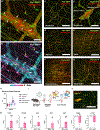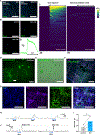Highly neurogenic glia from human and mouse myenteric ganglia generate functional neurons following culture and transplantation into the gut
- PMID: 39471175
- PMCID: PMC11697211
- DOI: 10.1016/j.celrep.2024.114919
Highly neurogenic glia from human and mouse myenteric ganglia generate functional neurons following culture and transplantation into the gut
Abstract
Enteric neural stem cell (ENSC) therapy offers great promise for neurointestinal diseases; however, current isolation methods yield insufficient neurons for regenerative applications. Multiomic profiling of enteric glial cells (EGCs) suggests that subpopulations within myenteric ganglia (MyGa) are a reservoir of highly neurogenic ENSCs. Here, we describe protocols to enrich for intraganglionic EGCs by isolating intact fragments of MyGa, generating cultures with higher neuronal purity than traditional methodologies isolating intramuscular single cells (IM-SCs). MyGa-derived EGCs transdifferentiate into more neurons than IM-SC-derived EGCs do, confirming their neurogenic predisposition. Following transplantation to the mouse intestine, MyGa-derived neurons generate calcium transients and activate smooth muscle in response to optogenetic stimulation. In the human intestine, MyGa-derived cells are similarly highly neurogenic, are enriched for a distinct progenitor population identified by single-cell RNA sequencing (scRNA-seq), and exhibit neuromuscular connectivity following xenogeneic transplantation into mice. Highly neurogenic ENSCs are preferentially located within the MyGa, and their selective isolation offers considerable potential for therapy.
Keywords: CP: Neuroscience; CP: Stem cell research; cell therapy; enteric glial cell; enteric nervous system; enteric neural stem cell; enteric neuron; myenteric ganglia; neurogenesis; neuroregeneration; postnatal; regeneration.
Copyright © 2024 The Author(s). Published by Elsevier Inc. All rights reserved.
Conflict of interest statement
Declaration of interests R.S., A.M.G., and R.H. are inventors on US provisional patent application 63/659,137 submitted by The General Hospital Corporation that covers “Isolation of enteric neurons and progenitors from the enteric ganglia for cell therapy.”
Figures







Similar articles
-
Postnatal human enteric neuronal progenitors can migrate, differentiate, and proliferate in embryonic and postnatal aganglionic gut environments.Pediatr Res. 2017 May;81(5):838-846. doi: 10.1038/pr.2017.4. Epub 2017 Jan 6. Pediatr Res. 2017. PMID: 28060794 Free PMC article.
-
Single-cell multiome sequencing clarifies enteric glial diversity and identifies an intraganglionic population poised for neurogenesis.Cell Rep. 2023 Mar 28;42(3):112194. doi: 10.1016/j.celrep.2023.112194. Epub 2023 Feb 28. Cell Rep. 2023. PMID: 36857184 Free PMC article.
-
Estrogen receptor β controls proliferation of enteric glia and differentiation of neurons in the myenteric plexus after damage.Proc Natl Acad Sci U S A. 2018 May 29;115(22):5798-5803. doi: 10.1073/pnas.1720267115. Epub 2018 May 14. Proc Natl Acad Sci U S A. 2018. PMID: 29760072 Free PMC article.
-
Analysis of enteric neurons, glia and their interactions using explant cultures of the myenteric plexus.Dev Neurosci. 1987;9(4):201-27. doi: 10.1159/000111623. Dev Neurosci. 1987. PMID: 3322784 Review.
-
Concise Review: Cellular and Molecular Mechanisms of Postnatal Injury-Induced Enteric Neurogenesis.Stem Cells. 2019 Sep;37(9):1136-1143. doi: 10.1002/stem.3045. Epub 2019 Jun 24. Stem Cells. 2019. PMID: 31145813 Review.
Cited by
-
Effects of aged garlic extract on aging?related changes in gastrointestinal function and enteric nervous system cells.Exp Ther Med. 2025 Mar 26;29(5):103. doi: 10.3892/etm.2025.12853. eCollection 2025 May. Exp Ther Med. 2025. PMID: 40171138 Free PMC article.
References
-
- Furness JB (2012). The enteric nervous system and neurogastroenterology. Nat. Rev. Gastroenterol. Hepatol 9, 286–294. - PubMed
-
- Furness JB (2006). The Enteric Nervous System (Blackwell Publishing; ).
-
- Goldstein AM, Thapar N, Karunaratne TB, and De Giorgio R (2016). Clinical aspects of neurointestinal disease: pathophysiology, diagnosis, and treatment. Dev. Biol 417, 217–228. - PubMed
Publication types
MeSH terms
Grants and funding
LinkOut - more resources
Full Text Sources
Molecular Biology Databases
Miscellaneous

